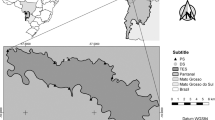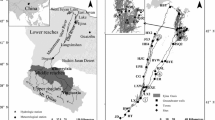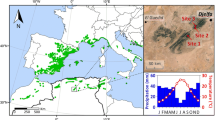Abstract
Key message
Baldcypress, a long-lived species of riparian habitats, is sensitive to interannual climate variability. The annual radial growth is associated with the Standardized Precipitation Evaporation Index (SPEI) and Palmer Drought Severity Index (PDSI), both depending on a water balance.
Abstract
The baldcypress (Taxodium mucronatum Ten.) is a long-lived species and Mexico’s national tree. The objective of this study was to analyze the dendroclimatic response of baldcypress at sites located on the transitional zone between the semiarid and subtropical regions of Mexico, known as the Middle Zone of the state of San Luis Potosi, Mexico. The first site, Los Peroles (LPO), is a wetland where the oldest known baldcypress specimens in Mexico are found. The second site, Rio Verde (RVDE), is a riparian site located along a tributary of the Moctezuma River that drains into the Gulf of Mexico. Two ring-width chronologies were analyzed. The first one from LPO with a length of 633 years and the second one from RVDE with a length of 423 years. The species responded positively to the seasonal January–July precipitation (r = 0.52, p = 0.001) and negatively to the maximum monthly temperature of January, May, and June (r = − 0.42, −0.46, and −0.34; respectively). The average chronology was significantly associated with the mean January–August Standardized Precipitation Evaporation Index (SPEI) (r = 0.62, p = 0.000). An SPEI reconstruction was developed for the period 1575–1996 where the most prolonged and severe droughts were found at 70-year peaks in the El Niño Southern Oscillation frequency band. The annual radial growth of the species is a suitable indicator of the January–August water availability, and is important information that can be used to establish water management strategies for this semiarid environment and to preserve millennial baldcypress specimens.






Similar content being viewed by others
References
Bates BC, Kundzewicz ZW, Wu S, Palutikof JP (eds) (2008) Climate change and water. Technical paper of the intergovernmental panel on climate change, IPCC Secretariat, Geneva. https://www.ipcc.ch/publication/climate-change-and-water-2/. Accessed 10 July 2019
Biondi FK, Weikul K (2004) DENDROCLIM2002: a C ++ program for statistical calibration of climate signals in tree-ring chronologies. Comput Geosci 30:303–311. https://doi.org/10.1016/j.cageo.2003.11.004
Bradley RS (1999) Paleoclimatology reconstructing climates of the Quaternary. 2nd edn. International Geophysics Series volume 68. Elsevier Academic Press, Massachusetts
Briffa KR, Schweingruber FH, Jones PD, Osborn TJ, Harris IC, Shiyatov SG, Vaganov EA, Grudd H (1998) Trees tell of past climates: but are they speaking less clearly today? Philos Trans Soc B 353:65–73. https://doi.org/10.1098/rstb.1998.0191
Brown CA, Montz GN (1986) Baldcypress: the tree unique, the wood eternal. Claitor’s Publishing Division, Baton Rouge
Bruun JT, Allen JI, Smyth TJ (2017) Heartbeat of the Southern Oscillation explains ENSO climate resonances. J Geophys Res-Oceans 122:6746–6772. https://doi.org/10.1002/2017jc012892
Bunn A, Korpela M, Biondi F, Campelo F, M’erian P, Qeadan F, Zang C, Pucha-Cofrep D, Wernicke J (2018) dplR: dendrochronology program library in R. R package (version 1.6.7). https://r-forge.r-project.org/projects/dplr/. Accessed 01 July 2019
Carlón-Allende T, Villanueva-Díaz J, Mendoza ME, Pérez-Salicrup DR (2018) Climatic signal in earlywood and latewood in conifer forests in the Monarch Butterfly Biosphere Reserve, Mexico. Tree-Ring Res 74:63–75. https://doi.org/10.3959/1536-1098-74.1.63
Cerano-Paredes J, Villanueva-Díaz J, Valdez-Cepeda RD, Méndez-González J, Constante-García V (2011) Sequías reconstruidas en los últimos 600 años para el noreste de México. Rev Mex Cienc Agr Publicación Especial No. 2:235–249
Cleaveland MK, Stahle DW, Therrell MD, Villanueva-Díaz J, Burns BT (2003) Tree-ring reconstructed precipitation and tropical teleconnections in Durango, Mexico. Clim Change 59:369–388. https://doi.org/10.1023/A:1024835630188
Constante-García V, Villanueva-Díaz J, Cerano-Paredes J, Cornejo-Oviedo EH, Valencia-Manzo S (2009) Dendrocronología de Pinus cembroides Zucc. y reconstrucción de precipitación estacional para el sureste de Coahuila. Rev Cien For Mex 34:17–39. http://www.scielo.org.mx/pdf/cfm/v34n106/v34n106a2.pdf. Accessed 10 July 2019
Cook ER (1987) The decomposition of tree-ring series for environmental studies. Tree Ring Bull 47:37–59
Cook ER, Seager R, Heim RR Jr, Vose RS, Herweijer C, Woodhouse C (2010) Megadroughts in North America: placing IPCC projections of hydroclimatic change in a long-term palaeoclimate context. J Quat Sci 25:48–61. https://doi.org/10.1002/jqs.1303
Cortés-Barrera EN, Villanueva-Díaz J, Estrada-Ávalos J, Nieto de Pascual Pola C, Guerra de la Cruz V, Vázquez Cuecuecha O (2010) Utilización de Taxodium mucronatum Ten. para determinar la variación estacional de la precipitación en Guanajuato. Rev Mex Cienc For 1:159–170. http://www.scielo.org.mx/pdf/remcf/v1n1/v1n1a13.pdf. Accessed 10 July 2019
Davidson GR, Laine BC, Galicki SJ, Threlkeld ST (2006) Root zone hydrology: why bald cypress in flooded wetlands growth more when it rains. Tree-Ring Res 62:3–12. https://doi.org/10.3959/1536-1098-62.1.3
De Gortari-Ludlow N (2009) Agua y tierra en la Cuenca del Río Verde, SLP., México, y sus diferentes regímenes jurídicos, siglos XVI–XVIII. Dissertation, Universidad Autónoma de San Luis Potosí, Mexico. https://ninive.uaslp.mx/xmlui/bitstream/handle/i/3659/MCA1AYT00901.pdf?sequence=3&isAllowed=y. Accessed 10 July 2019
Denny GC, Arnold MA (2007) Taxonomy and nomenclature of baldcypress, pondcypress, and montezuma cypress: one, two, or three species? HortTech 17:125–127. https://doi.org/10.21273/HORTTECH.17.1.125
Díaz SC, Therrell MD, Stahle DW, Cleaveland MK (2002) Chihuahua (Mexico) winter-spring precipitation reconstructed from tree-rings, 1647–1992. Clim Res 22:237–244. https://www.jstor.org/stable/24868324. Accessed 10 July 2019
Díaz-Ramírez B, Villanueva-Díaz J, Cerano-Paredes J (2016) Reconstrucción de la precipitación estacional con anillos de crecimiento para la región hidrológica Presidio-San Pedro. Madera y Bosques 22:111–123. http://myb.ojs.inecol.mx/index.php/myb/article/view/480/655. Accessed 10 July 2019
Draper NR, Smith H (1981) Applied regression analysis, 2nd edn. Wiley, New York
Endfield DB, Mestas-Núñez AM, Trimble PJ (2001) The Atlantic multidecadal oscillation and its relation to rainfall and river flows in the continental US. Geophys Res Lett 28:2077–2080. https://doi.org/10.1029/2000GL012745
Enríquez-Peña EG, Suzán-Azpiri H (2011) Estructura poblacional de Taxodium mucronatum en condiciones contrastantes de perturbación en el estado de Querétaro, México. Rev Mex Biodivers 82:153–167. http://revista.ib.unam.mx/index.php/bio/article/view/380/350. Accessed 10 July 2019
ERIC III Versión 3.2. 2013. Extractor rápido de información climatológica. Instituto Mexicano de Tecnología del Agua. CONAGUA, Mexico https://www.imta.gob.mx/productos/software/eric-iii-version-3-2-extractor-rapido-de-informacion-climatolo-detail. Accessed 01 July 2019
Flores I, Campos-Aranda DF (1998) Detección de períodos de sequía en la zona media del estado de San Luis Potosí, con base en registros de precipitación mensual. Ingeniería Hidráulica en México 13:45–56. http://revistatyca.org.mx/ojs/index.php/tyca/articleCms/view/795/787. Accessed 10 July 2019
Florescano E (1980) Una historia olvidada: la sequía en México. Nexos 32:9–13. https://www.nexos.com.mx/?p=13353. Accessed 01 July 2019
Fritts HC (1976) Tree-rings and climate. Academic Press, New York
Fritts HC (1991) Reconstructing large-scale climatic patterns from tree-ring data: a diagnostic analysis. The University of Arizona Press, Tucson
García E (2004) Modificaciones al sistema de clasificación climática de Köppen, para adaptarlo a las condiciones de la República Mexicana. Instituto de Geografía, Universidad Nacional Autónoma de México. http://www.igeograf.unam.mx/sigg/utilidades/docs/pdfs/publicaciones/geo_siglo21/serie_lib/modific_al_sis.pdf. Accessed 03 July 2019
González-Elizondo M, González-Elizondo MS, Villanueva-Díaz J, Cerano-Paredes J (2017) Evaluación del potencial dendrocronológico de Pinus lumholtzii B.L. Rob. Fernald. Rev Mex Cienc For 8:28–54. https://cienciasforestales.inifap.gob.mx/index.php/ejemplares. Accessed 10 July 2019
Gou X, Dendg Y, GaoL Chen F, Cook E, Yang M, Zhang F (2015) Millennium tree-ring reconstructions of drought variability in the eastern Qilian mountains, northwest China. Clim Dyn 45:1761–1770. https://doi.org/10.1007/s00382-014-2431-y
Griffin D, Meko DM, Touchan R, Leaveitt SW, Woodhouse CA (2011) Latewood chronology development for summer-moisture reconstruction in the US, Southwest. Tree-Ring Res 67:87–101. https://doi.org/10.3959/2011-4.1
Holmes RL (1983) Computer-assisted quality control in tree-ring dating and measurement. Tree-Ring Bull 43:69–78. https://repository.arizona.edu/bitstream/handle/10150/262990/trb43.pdf?sequence=1&isAllowed=y. Accessed 10 July 2019
INEGI (1985) Síntesis geográfica del estado de San Luis Potosí. Instituto Nacional de Estadística, Geografía e Informática, Mexico
Keim RF, Amos JB (2012) Dendrochronological analysis of baldcypress (Taxodium distichium) responses to climate and contrasting flood regimes. Can J For Res 42:423–436. https://doi.org/10.1139/x2012-001
Li J, Shang-ping X, Cook ER, Morales MS, Christie NC Johnson, Chen F, D’Arrigo R, Fowler AM, Gou X, Fang K (2013) El Niño modulations over the past seven centuries. Nat Clim Change 3:822–826. https://doi.org/10.1038/nclimate1936
Luque E (1923) Voto razonado para elegir el árbol nacional, 1921. Revista México Forestal 9–10:3
Magaña V, Pérez JL, Vázquez LL, Carrizosa E, Pérez J (1999) El Niño y el clima. In: Magaña V (ed) Los impactos del Niño en México. SEP-CONACYT, Mexico
Mantua NJ, Hare SR, Zhang Y, Wallace JM, Francis RC (1997) A pacific interdecadal climate oscillation with impacts on salmon production. Bull Am Meteorol Soc 78:1069–1080. https://doi.org/10.1175/1520-0477(1997)078%3c1069:APICOW%3e2.0.CO;2
Martínez M (1963) Las pináceas mexicanas, 3rd edn. Universidad Nacional Autónoma de México, Mexico
Mattoon WR (1915) The Southern Cypress. USDA Bulletin No. 272. Washington, D.C. https://archive.org/details/southerncypress272matt/page/n1. Accessed 10 July 2019
Méndez M, Magaña V (2010) Regional aspects of prolonged meteorological droughts over Mexico and Central America. J Clim 23:1175–1188. https://doi.org/10.1175/2009JCLI3080.1
Naiman RJ, Decamps H, Pollock M (1993) The role of riparian corridors in maintaining regional biodiversity. Ecol Appl 3:209–212. https://doi.org/10.2307/1941822
Ropelewski CF, Jones PD (1987) An extension of the Tahiti-Darwin Southern oscillation Index. 1987. Mon Weather Rev 115:2161–2165. https://doi.org/10.1175/1520-0493(1987)115%3c2161:AEOTTS%3e2.0.CO;2
Rzedowski J (1978) Vegetación de México. Limusa, México
Schweingruber FH (1996) Tree rings and environment. Dendroecology. Paul Haupt, Berne
Seager R, Ting M, Davis M, Cane M, Nike N, Nakumara J, Lie C, Cook E, Stahle D (2009) Mexican drought: an observational modeling and tree ring study of variability and climate change. Atmosfera 21:1–31. https://www.revistascca.unam.mx/atm/index.php/atm/article/view/8616/8086. Accessed 10 July 2019
Speer JH (2010) Fundamentals of tree ring research. University of Arizona Press, Tucson
Stahle DW, Cleaveland MK (1992) Reconstruction and analysis of spring rainfall over the Southeastern US for the past 1000 years. Bull Am Meteorol Soc 73:1947–1961. https://doi.org/10.1175/1520-0477(1992)073%3c1947:RAAOSR%3e2.0.CO;2
Stahle DW, Cook ER, White JWC (1985) Tree-ring dating of baldcypress and the potential for millennia-long chronologies in the Southeast. Am Antiquity 50(4):796–802. https://doi.org/10.2307/280168
Stahle DW, D’Arrigo RD, Krusic PJ, Cleaveland MK, Cook ER, Allan RJ, Cole JE, Dunbar RB, Therrell MD, Gay DA, Moore MD, Stokes MA, Burns BT, Villanueva-Diaz J, Thompson LG (1998) Experimental dendroclimatic reconstruction of the Southern Oscillation. Bull Am Meteorol Soc 79:2137–2152. https://doi.org/10.1175/1520-0477(1998)079%3c2137:EDROTS%3e2.0.CO;2
Stahle DW, Villanueva-Diaz J, Burnette DJ, Cerano-Paredes J, Heim RR Jr, Fye FK, Acuna-Soto R, Therrell MD, Cleaveland MK, Stahle DK (2011) Major Mesoamerican droughts of the past millennium. Geophys Res Lett 38:L05703. https://doi.org/10.1029/2010GL046472
Stahle DW, Burnette DJ, Villanueva-Diaz J, Heim RR Jr, Fye FK, Cerano-Paredes J, Acuna-Soto R, Cleaveland MK (2012a) Pacific and Atlantic influences in Mesoamerican over the past millennium. Clim Dyn 39:1431–1446. https://doi.org/10.1007/s00382-011-1205-z
Stahle DW, Burnett DJ, Villanueva J, Cerano J, Fye FK, Griffin RD, Cleaveland MK, Stahle DK, Edmondson JR, Wolff KP (2012b) Tree-ring analysis of ancient baldcypress trees and subfossil wood. Quat Sci Rev 34:1–15. https://doi.org/10.1016/j.quascirev.2011.11.005b
Stahle DW, Cook ER, Burnette DJ, Villanueva J, Cerano J, Burns JN, Griffin D, Cook BI, Acuña R, Torbenson MCA, Szejner P, Howard IM (2016) The Mexican Drought Atlas: tree-ring reconstructions of the soil moisture balance during the late pre-Hispanic, colonial, and modern eras. Quat Sci Rev 149:34–60. https://doi.org/10.1016/j.quascirev.2016.06.018
Stanley VG, Swanson FJ, McKee WA, Cummins KW (1991) An ecosystem perspective of riparian zones, focus on links between land and water. Bioscience 41:540–551. https://doi.org/10.2307/1311607
Steel RGD, Torrie JH (1980) Principles and procedures of statistics. A biometrical approach, 2nd edn. McGraw-Hill, New York
Stokes MA, Smiley TL (1968) An introduction to tree-ring dating. The University of Chicago Press, Chicago
Suzán-Azpiri H, Enríquez-Peña G, Malda-Barrera G (2007) Population structure of the mexican baldcypress (Taxodium mucronatum Ten.) in Queretaro, Mexico. For Ecol Manag 242:243–249. https://doi.org/10.1016/j.foreco.2007.01.041
Tarik CG, Aslak G, Viliam S (2017) R package “biwavelet”: conduct univariate and bivariate wavelet analyses (Version 0.20.15). https://github.com/tgouhier/biwavelet. Accessed 01 July 2019
Terán-Cuevas A (2010) Análisis de escenarios de lluvia en México. Dissertation. Centro Interdisciplinario de Investigaciones y Estudios sobre Medio Ambiente y Desarrollo (CIIEMAD), IPN, Mexico
Therrell MD, Stahle DW, Villanueva-Diaz J, Cornejo-Oviedo EH, Cleaveland MK (2006) Tree-ring reconstructed maize yield in central México: 1474–2001. Climatic Change 74:493–504. https://doi.org/10.1007/s10584-006-6865-z
Torbenson MCA, Stahle DW, Howard IM, Burnette DJ, Villanueva-Díaz J, Cook ER, Griffin D (2019) Multidecadal modulation of the ENSO teleconnection to precipitation and tree growth over subtropical North America. Paleoceanogr paleoclimatol 34:886–900. https://doi.org/10.1029/2018PA003510
Van De Veer RL (2011) Dendroclimatic reconstructions from bald cypress in southwestern Indiana. Dissertation, Department of Earth and Environmental Systems, Indiana State University
Vicente-Serrano SM, Beguería S, López-Moreno JI (2010) A multiscalar drought index sensitive to global warming: the standardized precipitation evapotranspiration index. J Climate 23:1696–1718. https://doi.org/10.1175/2009JCLI2909.1
Villanueva-Díaz J, Hernández-Reyna A (2004) Estructura y crecimiento anual de algunas mezquiteras en San Luis Potosí. Cienc For Mex 29:7–27
Villanueva-Diaz J, Luckman BH, Stahle DW, Therrell MD, Cleaveland MK, Cerano-Paredes J, Gutierrez-Garcia G, Estrada-Avalos J, Jasso-Ibarra R (2005) Hydroclimatic variability of the upper Nazas basin: water management implications for the irrigated area of the Comarca Lagunera. Dendrochronologia 22:215–223. https://doi.org/10.1016/j.dendro.2005.04.005
Villanueva-Díaz J, Hernández-Reyna A, García-Sánchez F, Cornejo-Oviedo EH, Stahle DW, Therrell MD, Cleaveland MK (2003) Análisis estructural de un rodal de sabino (Taxodium mucronatum Ten.) y vegetación circunvecina en los Peroles, San Luis Potosí, México. Cienc For Mex 28:57–79
Villanueva-Díaz J, Stahle DW, Luckman BH, Cerano-Paredes J, Therrell MD, Morán-Martínez R, Cleaveland MK (2007) Potencial dendrocronológico de Taxodium mucronatum Ten. y acciones para su conservación en México. Cienc For Mex 32:9–37
Villanueva-Díaz J, Cerano-Paredes J, Stahle DW, Constante-García V, Vázquez-Salem L, Estrada-Ávalos J, Benavides-Solorio JD (2010) Árboles longevos de México. Rev Mex Cienc For 1:1–23
Villanueva-Díaz J, Cerano-Paredes J, Benavides JD, Stahle DW, Estrada-Ávalos J, Constante-García V, Tostado-Plascencia M (2012) Reconstrucción de los niveles del Lago de Chapala con series dendrocronológicas de Taxodium mucronatum Ten. Rev Mexi Cienc For 3:55–68. http://www.scielo.org.mx/pdf/remcf/v3n14/v3n14a5.pdf. Accessed 10 July 2019
Villanueva-Díaz J, Cerano-Paredes J, Estrada-Ávalos J, Constante-García V, Stahle DW (2014) Reconstrucción de escurrimiento histórico de la cuenca alta del Río Nazas, Durango. Revista Chapingo: Serie Zonas Áridas 13:21–25. https://doi.org/10.5154/r.rchsza.2012.06.036
Villanueva-Díaz J, González-Elizondo M, Cerano-Paredes J, Estrada-Ávalos J, Martínez-Sifuentes AR, Rosales-Mata S (2018) Red dendrocronológica de pino triste (Pinus lumholtzii B.L. Rob & Fernald) en la Sierra Madre Occidental para reconstrucción de lluvia estacional Madera y Bosques 24:e2421530:1–31. https://doi.org/10.21829/myb.2018.2421530
Walsh C, Dawson JO (2014) Variation in buttressing form and stem volume ratio of baldcypress trees. Transactions of the Illinois State Academy of Science 107:5–11. http://ilacadofsci.com/wp-content/uploads/2014/01/107-02MS1307Final.pdf. Accessed 01 July 2019
Wigley TML, Brifa KR, Jones PD (1984) On the average value of correlated time series, with applications in dendroclimatology and hydrometeorology. Am Meteorol Soc 23:201–213. https://doi.org/10.1175/1520-0450(1984)023%3c0201:OTAVOC%3e2.0.CO;2
Wolter K, Timlin MS (2011) El Niño/Southern Oscillation behavior since 1871 as diagnosed in an extended multivariate ENSO index (MEI.ext). Int J Climatol 31:1074–1087. https://doi.org/10.1002/joc.2336
Woodhouse CA, Lukas JJ (2006) Drought, tree rings and water resource management in Colorado. Can Water Resour J 31:297–310. https://doi.org/10.4296/cwrj3104297
Wright PB (1979) Persistence of rainfall anomalies in the central pacific. Nature 277:371–374. https://doi.org/10.1038/277371a0
Acknowledgements
We thank to Agustín Hernández-Reyna for technical support in the describing botanical composition of Los Peroles site, and for assisting with coring some of the oldest bald cypress specimens in this location. We would like to acknowledge the Ecological Department of Rio Verde municipality for providing field work permits at sampling sites of this study.
Funding
This study was funded by CONACYT (FOINS) “Nacional Problems” (Grant no: APN-2976).
Author information
Authors and Affiliations
Corresponding author
Ethics declarations
Conflict of interest
The authors declare that they have no conflict of interest.
Additional information
Communicated by E. van der Maaten.
Publisher's Note
Springer Nature remains neutral with regard to jurisdictional claims in published maps and institutional affiliations.
Rights and permissions
About this article
Cite this article
Villanueva-Díaz, J., Stahle, D.W., Therrell, M.D. et al. The climatic response of baldcypress (Taxodium mucronatum Ten.) in San Luis Potosi, Mexico. Trees 34, 623–635 (2020). https://doi.org/10.1007/s00468-019-01944-0
Received:
Accepted:
Published:
Issue Date:
DOI: https://doi.org/10.1007/s00468-019-01944-0




